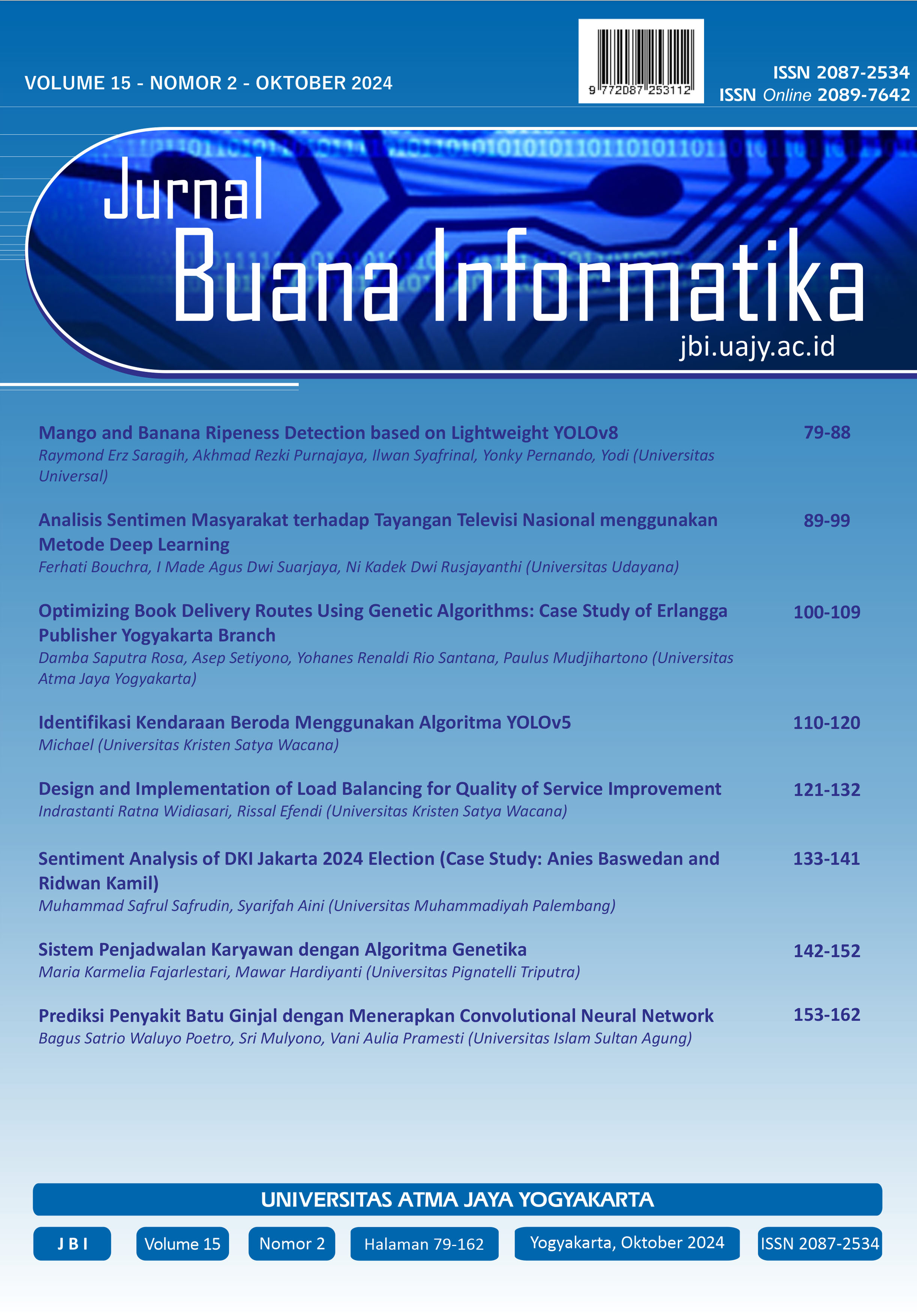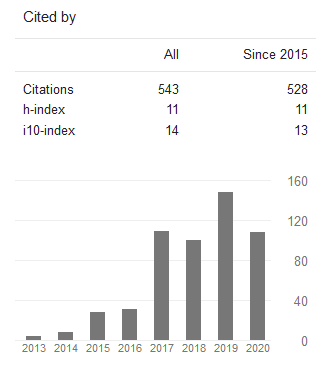Sentiment Analysis of DKI Jakarta 2024 Election (Case Study: Anies Baswedan and Ridwan Kamil)
Keywords:
Anies Baswedan, Jakarta, regional head election, Ridwan Kamil, sentiment analysis, analisis sentimen, pilkadaAbstract
This study analyzes public sentiment toward two potential candidates for the 2024 Jakarta gubernatorial election, Anies Baswedan and Ridwan Kamil, using Twitter data. Applying the TextBlob model for text extraction and Naive Bayes for sentiment classification found that sentiment toward Anies Baswedan is mostly positive, 52.2%, while neutral sentiment dominates for Ridwan Kamil. The accuracy of the Naive Bayes model reached 80% for Anies Baswedan and 72% for Ridwan Kamil, with higher precision, recall, and F1-score for Anies' data. These results indicate that the model is more accurate in classifying sentiment toward Anies compared to Ridwan Kamil. The implications of these findings are important for political campaign strategies, where Anies can leverage the existing positive support, while Ridwan Kamil has an opportunity to strengthen public engagement through a more strategic approach, in line with the sentiment emerging on social media.
References
D. A. Kristiyanti, Normah, and A. H. Umam, “Prediction of Indonesia presidential election results for the 2019–2024 period using Twitter sentiment analysis,” in Proceedings of the 2019 5th International Conference on New Media Studies (CONMEDIA), 2019, pp. 36–42, doi: 10.1109/CONMEDIA46929.2019.8981823.
P. Gaur, S. Vashistha, and P. Jha, “Twitter sentiment analysis using Naive Bayes-based machine learning technique,” in Sentiment Analysis and Deep Learning, Singapore, 2023, pp. 367–376.
A. A. Firdaus, A. Yudhana, and I. Riadi, “Prediction of presidential election results using sentiment analysis with pre and post candidate registration data,” Khazanah Informatika: Jurnal Ilmu Komputer dan Informatika, vol. 10, no. 1, pp. 36–46, 2024.
E. Hasibuan and E. A. Heriyanto, “Analisis sentimen pada ulasan aplikasi Amazon Shopping di Google Play Store menggunakan Naive Bayes classifier,” Jurnal Teknik dan Science, 2022. [Online]. Available: https://api.semanticscholar.org/CorpusID:255367773
L. Dey, S. Chakraborty, A. Biswas, B. Bose, and S. Tiwari, “Sentiment analysis of review datasets using Naive Bayes and K-NN classifier,” International Journal of Information Engineering and Electronic Business, vol. 8, no. 4, pp. 54–62, Jul. 2016, doi: 10.5815/ijieeb.2016.04.07.
P. Kathiravan, R. Saranya, and S. Sekar, “Sentiment analysis of COVID-19 tweets using TextBlob and machine learning classifiers,” in Proceedings of the International Conference on Data Science and Applications, Singapore, 2023, pp. 89–106.
F. F. Mailoa, “Analisis sentimen data Twitter menggunakan metode text mining tentang masalah obesitas di Indonesia,” Journal of Information Systems for Public Health, vol. 6, no. 1, p. 44, 2021, doi: 10.22146/jisph.44455.
B. S. Shekhawat, “Sentiment Classification of Current Public Opinion on BREXIT: Naïve Bayes Classifier Model vs Python’s TextBlob Approach,” MSc thesis, School of Computing, National College of Ireland, Dublin, Ireland, 2019.
I. G. S. Mas Diyasa, N. M. I. M. Mandenni, M. I. Fachrurrozi, S. I. Pradika, K. R. N. Manab, and N. R. Sasmita, “Twitter sentiment analysis as an evaluation and service base on Python TextBlob,” IOP Conference Series: Materials Science and Engineering, vol. 1125, no. 1, p. 012034, May 2021, doi: 10.1088/1757-899X/1125/1/012034.
S. Paudel, P. W. C. Prasad, A. Alsadoon, M. D. R. Islam, and A. Elchouemi, “Feature selection approach for Twitter sentiment analysis and text classification based on chi-square and Naïve Bayes,” in International Conference on Applications and Techniques in Cyber Security and Intelligence (ATCI 2018), J. Abawajy, K.-K. R. Choo, R. Islam, Z. Xu, and M. Atiquzzaman, Eds. Cham: Springer International Publishing, 2019, pp. 281–298.
A. Goel, J. Gautam, and S. Kumar, “Real-time sentiment analysis of tweets using Naive Bayes,” 2016 2nd International Conference on Next Generation Computing Technologies (NGCT), pp. 257–261, 2016. [Online]. Available: https://api.semanticscholar.org/CorpusID:17961386.
E. Setiani and W. Ce, “Text classification services using Naive Bayes for Bahasa Indonesia,” in Proceedings of the 2018 International Conference on Information Management and Technology (ICIMTech), 2018, doi: 10.1109/ICIMTech.2018.8528258.
S. Zainudin, “Sentiment analysis techniques in recent works,” Science and Innovation Advances Conference, 2015, doi: 10.1109/SAI.2015.7237157.
S. Sarica and J. Luo, “Stopwords in technical language processing,” Public Library of Science ONE (PLOS ONE), vol. 16, no. 8, Aug. 2021, doi: 10.1371/journal.pone.0254937.
A. Q. Surbakti, R. Hayami, and J. Al Amien, “Analisa tanggapan terhadap PSBB di Indonesia dengan algoritma decision tree pada Twitter,” Jurnal Computer Science and Information Technology), 2021. [Online]. Available: https://api.semanticscholar.org/CorpusID:246335901.
A. A. Siswandi, Y. Permana, and A. Emarilis, “Stemming analysis Indonesian language news text with Porter algorithm,” Journal of Physics: Conference Series, vol. 1845, 2021. [Online]. Available: https://api.semanticscholar.org/CorpusID:233802494.
K.-M. Schneider, “Techniques for improving the performance of Naive Bayes for text classification,” in Computational Linguistics and Intelligent Text Processing, A. Gelbukh, Ed. Berlin, Heidelberg: Springer Berlin Heidelberg, 2005, pp. 682–693.
Downloads
Published
Issue
Section
License

This work is licensed under a Creative Commons Attribution-ShareAlike 4.0 International License.
Copyright of this journal is assigned to Jurnal Buana Informatika as the journal publisher by the knowledge of author, whilst the moral right of the publication belongs to author. Every printed and electronic publications are open access for educational purposes, research, and library. The editorial board is not responsible for copyright violation to the other than them aims mentioned before. The reproduction of any part of this journal (printed or online) will be allowed only with a written permission from Jurnal Buana Informatika.
This work is licensed under a Creative Commons Attribution-ShareAlike 4.0 International License.










